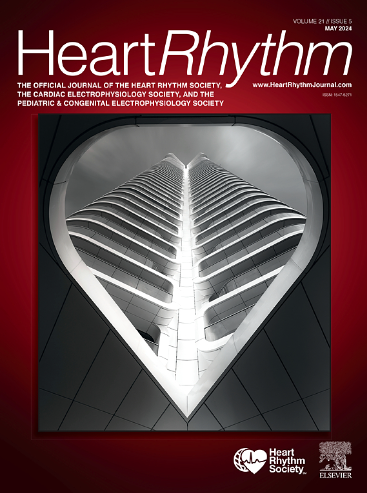Consequences of electrocardiography screening for prolonged QTc in neonates—A systematic review
IF 5.7
2区 医学
Q1 CARDIAC & CARDIOVASCULAR SYSTEMS
引用次数: 0
Abstract
Background
An ongoing discussion has been the effectiveness of neonatal electrocardiography (ECG) screening for long QT syndrome (LQTS).
Objective
The aim of this systematic review was to assess the consequences of ECG screening for prolonged corrected QT (QTc) interval in infants younger than 1 month.
Methods
We searched the PubMed, Scopus, and Web of Science databases in June 2024. The incidence rates of prolonged QTc, defined as >450 ms, were calculated per 1000 neonates. Prolonged QTc cases, including normalization during follow-up, LQTS diagnosis, and sudden infant death syndrome (SIDS), were analyzed.
Results
Eight studies were included. Five studies using a cutoff QTc >450 ms reported incidences ranging from 5 (95% confidence interval [CI], 5–6) to 79 (CI, 60–102) per 1000 neonates. Six studies with a cutoff of >460 ms reported incidences ranging from 1 (CI, 1–2) to 53 (CI, 50–57). Five studies (cutoff QTc >470 ms) had incidences varying from 1 (CI, 0–1) to 28 (CI, 21–35). In 6 studies, QTc normalization during follow-up occurred in 57.1% to 95.2% of neonates with prolonged QTc. The diagnosis of LQTS was reported in 4 studies, with 21 of 51,817 (0.04%) neonates later diagnosed with LQTS. Two studies reported SIDS outcomes, finding prolonged QTc in 8 of 24 and 3 of 3 SIDS cases.
Conclusion
The incidence of prolonged QTc varied widely across studies. Only a small proportion of neonates with prolonged QTc were diagnosed with LQTS during follow-up. Further research with standardized study factors and comprehensive genetic analysis is needed to determine the utility of and indications for neonatal ECG screening.
心电图筛查对新生儿延长QTc的影响——一项系统综述。
背景:新生儿心电图筛查长QT综合征(LQTS)的有效性一直在讨论中。目的:评价心电图筛查对1月龄以下婴儿纠正QT间期延长的影响。方法:于2024年6月检索PubMed、Scopus和Web of Science数据库。计算每1000名新生儿中延长QTc的发生率,定义为>450ms。对延长的QTc病例进行分析,包括随访期间的正常化、LQTS诊断或婴儿猝死综合征(SIDS)。结果:纳入8项研究。五项采用截断QTc bb0 450ms的研究报告的发病率为每1000名新生儿5例(95%置信区间(CI: 5-6)至79例(CI: 60-102)。6项截止时间为bb0 ~ 460ms的研究报告的发病率范围从1 (CI: 1-2)到53 (CI: 50-57)。5项研究(截止QTc为0 ~ 470ms)的发生率从1 (CI 0 ~ 1)到28 (CI 21 ~ 35)不等。在6项研究中,57.1%至95.2% QTc延长的新生儿在随访期间QTc恢复正常。四项研究报告了LQTS的诊断,51817名新生儿中有21名(0.04%)后来被诊断为LQTS。两项研究报告了SIDS的结果,发现8/24和3/3的SIDS病例QTc延长。结论:不同研究中QTc延长的发生率差异很大。在随访中,只有一小部分延长QTc的新生儿被诊断为LQTS。需要进一步研究标准化的研究因素和全面的遗传分析来确定新生儿心电图筛查的效用和适应症。
本文章由计算机程序翻译,如有差异,请以英文原文为准。
求助全文
约1分钟内获得全文
求助全文
来源期刊

Heart rhythm
医学-心血管系统
CiteScore
10.50
自引率
5.50%
发文量
1465
审稿时长
24 days
期刊介绍:
HeartRhythm, the official Journal of the Heart Rhythm Society and the Cardiac Electrophysiology Society, is a unique journal for fundamental discovery and clinical applicability.
HeartRhythm integrates the entire cardiac electrophysiology (EP) community from basic and clinical academic researchers, private practitioners, engineers, allied professionals, industry, and trainees, all of whom are vital and interdependent members of our EP community.
The Heart Rhythm Society is the international leader in science, education, and advocacy for cardiac arrhythmia professionals and patients, and the primary information resource on heart rhythm disorders. Its mission is to improve the care of patients by promoting research, education, and optimal health care policies and standards.
 求助内容:
求助内容: 应助结果提醒方式:
应助结果提醒方式:


